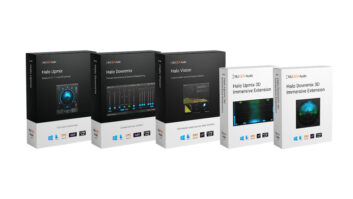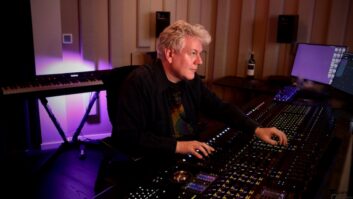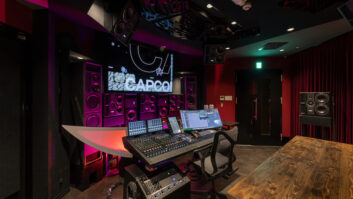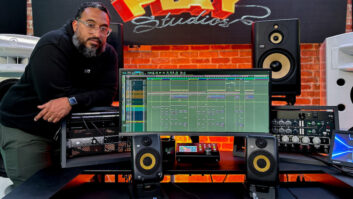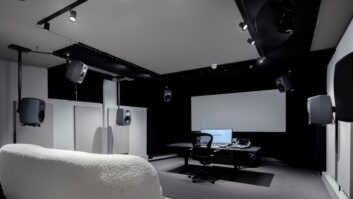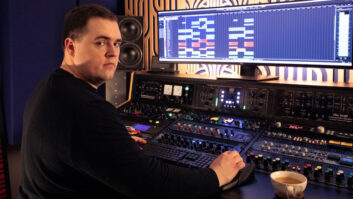Following a decade in which the studio industry was threatened by an economic recession, an explosion in home recording and rising costs in the face of stagnant rates, facilities here are reporting robust business and expressing hopes for continued prosperity.
Industry leaders attribute the healthy vital signs to a strong economy and a proliferation of surround sound production and digital audio workstations, all of which feed the city’s recording, mixing, mastering and post-production projects.
“For two years solid we have been remarkably, consistently good,” says Simon Andrews, owner of three-room Right Track Recording. “It doesn’t show, at this moment, any sign of abating. The economy is doing well. Record sales in the U.S. are up 11 percent, which is where the money is made. And last year CD sales were 10 percent above where they were the year before. The record companies have to put product out in the market and they’re flush with cash, so I don’t see a slowdown for another two years or so.”
Across town at the Sony Music Studios complex, VP of audio operations and marketing Ian Huckabee says, “Business has been extremely good for us this year. We’ve hit our stride. Today, we’ve got Corey Rooney, Rodney Jerkins and Walter Afanasieff in our rooms and Eric Foster waiting to get in.”
Sear Sound owner Walter Sear adds, “We’re cranking away with both rooms. We’re booked pretty much through the summer, and we’ve got some fancy people coming in, like David Bowie, and we recently had Lou Reed, Patti Smith and Paul McCartney.”
In fact, success in 2000 has been a double-edged sword for Sear. on the one hand, he relishes the steady stream of high-profile clients. on the other hand, he is frustrated that he can’t get into his own room until September to perform an upgrade on his custom Avalon board.
Other studio owners are finding that business is a tad behind where it was last year, but still within the range of what they consider healthy. For example, Quad Recording owner Lou Gonzalez-who operates five rooms in his flagship facility here and four in a Nashville studio he acquired last year-says, “The beginning of this year was not as good as last year. Last year was the best. There was a lot of work to be done, and people love working at Quad, so we did pretty well.”
Alex Abrash, manager at downtown haunt Kampo Studios, which recently installed a Solid State Logic Axiom-MT digital console, says, “our business is changing a lot. We’re struggling to grab a different level of business. We’re looking for major-label stuff and long-term projects. Maybe this year won’t be our best year, but our growth in terms of the kinds of projects we’re seeing has been explosive.”
For Abrash, leapfrogging from an SSL G to an Axiom has catapulted him into the big leagues. It’s been an exciting ride, if a bit unsettling at times-somewhat akin to taking one step back to take two steps forward.
Amid the transition, Abrash has found himself living moments that only existed in his dreams. on the day he was to host production legend Eddie Kramer for a 5.1-channel mix of Jimi Hendrix recordings from the legendary Isle of Wight performances, Abrash recalls thinking: “We’re mixing Jimi Hendrix material in surround today. How cool is that?”
If studio owners provide an accurate barometer of the recording industry, retailers are perhaps even better poised to measure its health, since they cater not only to the studios but also to the growing project and home-recording sectors.
Sam Ash Professional general manager Tim Finnegan says, “Business has been very good. It probably has to do with an excitement about surround sound. We’re finally starting to feel the effects of people understanding that there is a business out there-or close to being out there-with DVD-Audio.”
SURROUND PHENOMENONThe pickup in business resulting from multichannel production is manifested in sales of extra speakers and extra amplifiers, as well as in installations of complete systems, according to Finnegan.
At Sony, multichannel production has been a hallmark of the studio’s business and a source of pride for sister companies Sony Music Entertainment and Sony Electronics.
“Surround has grown,” says Huckabee. “We were definitely involved a year ago, but it’s mushrooming. We’re doing a lot of DVD work for Sony Music Entertainment. our facility has made a great investment in all the surround technologies, from amps and speakers to multichannel signal processors. We’re poised to handle the demand for DVD-Audio.”
Whereas surround sound pioneers had to retrofit consoles with multichannel monitoring capabilities, manufacturers are increasingly building 5.1-channel center sections into their mixers. At Quad, Gonzalez recently upgraded the software in his SSL Axiom-MT, and it now allows him to pan signals in the multichannel spectrum more easily.
“The new version of the software [PanPoint] lets you do the whole 5.1 panning thing with a pen, not even a joystick, on every channel,” the beaming Gonzalez says.
DAW EXPLOSIONAnother trend that is fueling business across the recording industry is the continued growth of digital audio workstations, particularly Digidesign’s ubiquitous Pro Tools platform.
Finnegan says, “Pro Tools continues to be a very strong product line for us.We’re still selling more full-fledged systems than [entry-level] 001s, but we’re selling absolutely more 001s than we thought we would. Surprisingly, the sales of 001s are not at the expense of the larger systems.”
In every recording and mixing studio polled by Mix, Pro Tools has infiltrated virtually every aspect of the production.
“We’re seeing Pro Tools integrated at every stage of the production,” says Huckabee. “It may start out in someone’s living room or home studio, and eventually, those tracks make their way over here on a hard drive. We’ve even had Pro Tools in on mastering sessions, where there’s typically the Pro Tools operator, the mastering engineer and the artist in the room togetheror connected via EDNet.”
Huckabee notes that Pro Tools is approaching the “commodity” level that products such as the SSL 9000J and Sony 3348 have attained. “At some point Pro Tools is probably going to be an expected piece of gear when you walk into a room,” he says. “You got your SSL 9000J, your 3348, your essential pieces of outboard gear, and your Pro Tools.”
Randy Ezratty, owner of mobile and post-production facility Effanel Music, recently acquired a Pro Tools system to address his clients’ overwhelming requests. Although Effanel uses otari RADAR as its primary live recording platform, Pro Tools has become critical to the studio’s post efforts, which take place either in its lavishly appointed, expandable truck or in a large control room-cum-tracking area in its Chelsea headquarters.
For Ezratty, the Pro Tools installation is only the latest in a series of steps he has taken to make Effanel increasingly versatile. other moves in that direction have included installing a 5.1-channel monitoring system in the AMS Neve Capricorn-equipped truck and adding a second Capricorn back in the studio (which also contains a surround-sound environment).
“Our clients know we’re doing as much post-production in our truck as we’re doing in our room,” says Ezratty. “There’s very little concern that it is a truck. We’ve managed to get past that.”
Commenting on the flow of work between the truck and the studio, Ezratty says, “The concept is working-the ability to move between two systems. Even from a monitoring standpoint, we’re not finding great differences in the way things sound.”
MASTERS OF THEIR DESTINYIf the recording/mixing sector of the business is healthy, traditionally the mastering business hums right along. Sure enough, Masterdisk owner Doug Levine reports strong, steady business in all his rooms, which are now staffed by Tony Dawsey, Howie Weinberg, Leon Zervos, Andy Van Dette and Roger Lian. Masterdisk also operates a burgeoning DVD authoring/mastering division.
“I go to SPARS luncheons regularly,” says Levine. “From the talk at the last lunch, the recording and mixing facilities seem to all be back doing well and talking about expanding. There was a while where, in New York, you just did not hear talk like that. It’s a much healthier atmosphere than when people were talking about cutting rates. The economy’s booming, and it spills over to everything.”
one of the most lucrative niches for mastering houses is the cleaning up of hardcore hip hop tracks. This often edit-intensive aspect of the mastering workload provides a windfall for studios, since they essentially get to “work on the same project twice and create two versions,” according to Levine.
Even as they supply the industry’s seemingly insatiable appetite for product, mastering studios are still reeling from a tumultuous series of staff moves that had a domino effect on facilities from coast to coast.
“In my 26 years in the business, from about three years ago through a year ago was the most turbulent time I have ever seen in the mastering industry,” says Levine.
However, he’s quick to add that things have “quieted down. Mastering engineers don’t like to move around too much. Their room is an extension of what they do.”
Like other mastering studios, Masterdisk has fully embraced the surround-sound revolution. However, the studio has received less work from its core music clients than from other industries.
“Most of our DVD work has been Japanimation and feature films,” says Levine. “Every once in a while we get a record industry project, but there haven’t been many.”
NET GAINSStudio owners surveyed for this story have expressed surprisingly little concern about digital downloading of music and its potential adverse effect on record sales.
“The digital downloading of music hasn’t affected CD sales as of yet,” says Andrews.
Gonzalez adds, “I haven’t heard any of my clients being afraid of their music being pirated. When cassettes were the thing, everybody could make cassette copies as long and often as they wanted to, and it didn’t hurt the cassette business.”
In fact, Web-based production is helping some areas of the industry, notably retail. Finnegan says some of the growth in Sam Ash’s business can be attributed to the increase in the number of studios that supply content to such Internet concerns as clickradio.com.
ENGINEER GO HOMEAnother industry bugbear-at least in the estimation of some observers-is the home recording explosion, which began with modular digital multitracks in the early ’90s and evolved later in the decade with digital consoles, digital audio workstations and advances in digital audio resolution. However, for all the perceived dangers posed to traditional studios by home recording, owners of world-class facilities remain unruffled.
“Home recording never affects me,” says Gonzalez. “If I was trying now to start out, it would be affecting me, but nobody at home is going to have a 9000J and an Axiom-MT and a 3348. Also, we have an incredible mic selection and great-sounding rooms.”
Andrews adds, “I’ve seen project studios ever since Tascam came out with their 16-track, 11/42-inch recorder. I’ve seen high-end studios built by artists, and the media has always played that up and said, ‘This is going to affect the studio business,’ but it really hasn’t affected us.
“Running a world-class studio is a full-time business, so the artists that open high-end studios don’t realize that until the technology they put in needs to be replaced, or until they get bored working at home,” he continues. “I’ve always compared it to people who spend $50,000 putting in a private gym, and the first two years, they go in religiously every day. Then they end up going back to their old gym because it’s the only way they can get motivated to exercise.”
Other studio owners and managers say they aren’t immune to the home-recording movement as much as they’ve found ways to coexist with it.
“We’re cohabitating very well with home and project studios,” says Huckabee. “We’ve got clients now with home studios, and some of those clients are getting finished products from their studios, but a lot are coming in for the room acoustics and to mix. They trust us and they need an accurate environment to mix in.”
Elsewhere, home- and project-based recording has taken a bite out of the bottom line and forced professional studios to adjust their businesses. For instance, at Kampo, part of the rationale for installing the Axiom-MT and a new TC Electronic System 6000 multichannel effects processor was to stave off the threat of clients taking their work home.
“The home-studio phenomenon has been unbelievable in the past 10 years,” says Abrash. “It certainly has had an impact on commercial facilities. We have to provide products and services that people can’t do at home-not only the latest technology but the best people. We’re constantly trying to innovate and experiment.”
Abrash adds that the constant specter of losing business to smaller facilities has led Kampo to be more creative and flexible in its business practices. “It seems that every day in the studio business we’re doing things we never did before, like transferring this format to that one, or locking up one machine to another,” he says. “We’ve seen a bump in transfers from ADAT or DA-88 to Pro Tools or 3348. Transfer sessions are big now, and they’re not simple. I recently sent my chief tech to a class on transfers.”
Indeed, a cottage industry has developed to satisfy the demand for transfers, backups and audio restoration, as evidenced by the opening in 1998 of the TransferMat Studio within the auspices of high-end New York rental shop Toy Specialists.
Stocked with every imaginable digital and analog format, the TransferMat provides its customers with services ranging from file format conversions and timecode repair to editing and premastering of album material, according to Toy Specialists owner Bill Tesar.
CONSOLIDATION: FRIEND OR FOE?Another music industry dirty word that seems to raise surprisingly few hackles when whispered in the company of studio owners is consolidation.
Gonzalez says, “Consolidation has helped me in that I can do business with a more varied clientele and not worry about billing, because billing goes to the major labels and I get purchase orders, so I don’t have to worry about a little label not paying me. I haven’t had a bad receivable in a long time. I haven’t lost any money.”
on the other hand, some owners bemoan the loss of the traditionally intimate relationship between the studio and its indie label clients.
“The labels are getting more and more ornery, because they understand less and less about what goes on in a recording studio,” says Sear. “The number of companies is getting smaller and smaller, and they’re all getting swallowed up by the big boys. There are fewer and fewer companies to deal with, and A&R people know less and less about making records.”
Still, the recording industry in general is healthy, according to statistics from the Recording Industry Association of America, which indicate that U.S. shipments of prerecorded music totaled $14.6 billion in 1999, up 6.3% from $13.7 billion in 1998.
Andrews says, “This is a multibillion-dollar industry, which is concentrated in four regions: New York, Los Angeles, Nashville and, to a lesser extent, Miami. There’s got to be several thousand albums released every year. There’s plenty of business to go around.”

